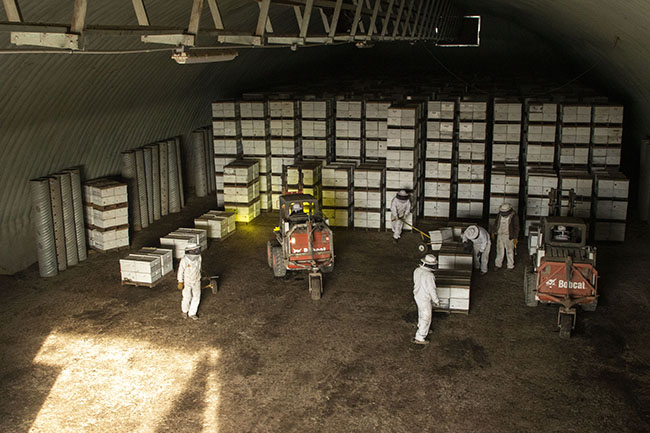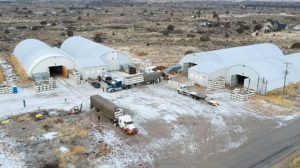
Winter 2022
Indoor storage of honeybees
Almonds and honeybees are uniquely linked industries that rely on each other for success. Over the past few decades, beekeepers have changed some of the ways they manage their bees in order to more effectively meet the demand for almond pollination services.
In January every year, beekeepers across the country begin loading over 4,000 trucks with about 400 honeybee colonies each to send them to California. But transporting bees into orchards is just the final step to delivering bees for pollination. Beekeepers must work year-round to deliver high quality colonies for the largest migratory farming event in the U.S.: almond pollination in Central California.

In colder climates, bees are in a state of dormancy during the winter, and beekeepers must interrupt this natural state and inspect every colony to make sure it will make the grade for pollination. Alternatively, many beekeepers bring their colonies to warmer parts of the U.S. to give their hives a more pleasant winter. Southern California and other southern states are popular destinations. But these warmer climates pose their own challenges. The bees remain active and require more labor, food and attention than they would in a fully dormant state.
One option for wintering bees that has gained significant popularity in the past few years is storing colonies indoors for winter. Currently, an estimated 500,000 colonies are moved into temperature-controlled indoor storage facilities, primarily in Idaho and adjacent states, to rest up before almond and other pollination events. These facilities range in complexity from potato storage sheds to purpose-built temperature and atmosphere-controlled buildings. Colonies can be stored indoors for anywhere from 6-10 weeks between November and January. The goal is to keep the colonies at a constant temperature cold enough to maintain full dormancy, to reduce labor and materials inputs during the winter months, and to help prevent any spread of pathogens between colonies.
Commercial beekeeping is a tough gig. The average migratory beekeeper loses approximately one third of their colonies every year, necessitating massive replacement costs to meet pollination contracts and stay profitable. Some beekeepers have turned to indoor storage as a new tool in their kit to improve colony health and survival. They must balance the cost of these buildings to be economical.

Despite the many clear benefits of indoor storage, beekeepers have a saying: “Indoor storage is not a hospital – sick bees in, sick bees out.” These beekeepers must work all year to ensure the quality of the colonies going into storage is top notch so that they can hit the ground running in almond orchards come spring.
Investing in indoor storage resources, education and research helps beekeepers assess the viability and benefits for themselves, and helps them to successfully manage bees in indoor storage. This fall, the Almond Board of California, Project Apis m., and Washington State University are collaborating to host an indoor storage conference for beekeepers. Beekeepers can learn more about this conference at ProjectApism.org/Indoor-Storage-Conference-2021, where they can also find a technical management guide funded by Healthy Hives and created by Washington State University and Project Apis m.
Photo: Beekeepers inspect and move colonies at an indoor storage facility in Blackfoot, Idaho, in January in preparation for California almond pollination. Photos: Project Apis m.







